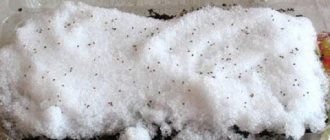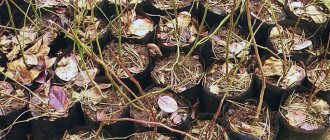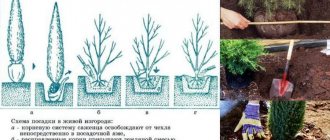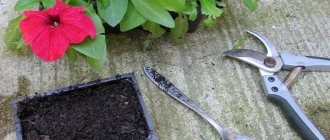Petunia is a perennial plant. It is popular among gardeners due to its beautiful and long-lasting flowering, hardiness and low maintenance requirements. Due to climatic conditions in our country, it is often grown as an annual.
However, experienced gardeners know that if you take care of a plant in the garden in a timely manner, it will survive the winter in your apartment and become a quality planting material for the next year. How to preserve petunia until spring at home, read the article.
Conditions for a successful wintering of petunias
Petunia is an unpretentious plant that takes root quickly and does not require much attention from the gardener. It does not have to be grown every year from new planting material. The plant will easily overwinter at home until the next season and become a mother plant for planting material.
To preserve petunia in an apartment in winter, it is important to provide it with suitable conditions :
- Temperature . The room should not be too hot or cold. The plant feels comfortable at temperatures from 0 to +15°C. Optimal values +10…+15°C.
- Air humidity . If the indoor air is too dry, the plant's leaves will begin to turn yellow and dry out. The hot air from heating devices is especially dangerous, which leads to the death of the queen cell. Optimal humidity levels for petunia are 75-80%.
- Lighting . During wintering, the plant does not require the use of additional lighting devices. It is enough to place the pot near the window.
- Watering . In winter, a minimal amount of watering is required, but the soil should not dry out or crack. On average, the procedure is carried out 2-3 times a month with water at room temperature. A couple of days after watering, the soil is loosened. Water is poured only at the root.
- Feeding . During wintering, the plant does not require fertilizing.
Petunia can overwinter in an apartment as a houseplant . In this case, until spring it grows strongly and blooms less profusely. With this growing method, there is a high risk of the plant being damaged by diseases and pests.
This is interesting! Terry petunia reproduces exclusively by vegetative means. It does not form seeds due to the fact that they transform into petals.
A few words about petunia
This flower is loved for its incredible beauty and long flowering period. Petunia blooms in late spring and blooms until mid-autumn, so it will decorate your garden or apartment for a long period of time. Most gardeners grow petunia as an annual plant, since it begins to bloom in the first year after planting. If you have a rare variety, then it makes sense to leave the flower for winter storage. How to preserve petunia in winter will be discussed further.
Saving methods
There are two ways to preserve petunia for the winter . One of them involves transplanting the plant directly from the flowerbed into a pot, and the other involves the use of cuttings collected at the end of flowering. Each option has its own advantages and disadvantages.
Cuttings
Saving petunia cuttings for the next year allows you to get a hardy, profusely flowering plant by spring . In this case, in the fall, before the onset of frost, cuttings are taken from plants in the garden, which are immediately rooted in the ground or water. In winter, they do not need fertilizing or frequent watering. By spring, the gardener receives well-formed, abundantly flowering plants that are ready for planting in open ground.
Advantages of wintering petunias in the form of cuttings:
- There is no need to buy or grow seedlings from seeds. These methods of reproduction are labor-intensive and costly.
- Obtaining abundantly flowering plants. Young petunias grown from cuttings produce many more flowers than biennial plants.
- Easy storage. Petunia cuttings get sick less often and have greater hardiness than flowers dug up from a flowerbed and transplanted into a pot.
- Compactness. Cuttings in small cups take up less space than bushes in large flower pots.
- Early flowering. If you take cuttings and root the planting material in the fall, you will get a large number of flowering plants in the spring.
Mature plants
Many gardeners prefer to harvest not cuttings in the fall, but a mother plant . In this case, the petunia bush is dug up and transplanted into a pot. The culture tolerates this procedure well and continues to bloom.
This is the easiest way to help preserve petunias until next spring. It has a number of advantages :
- There is no need to grow seedlings from seeds or buy ready-made seedlings.
- Long flowering. Petunia dug up from a flowerbed continues to bloom even at home until the beginning of winter.
- In spring, you can plant a large flowering petunia bush in your flowerbed. By this time, the plant will have grown even more than last year.
- Variation in the use of the mother plant. The dug up petunia is planted as a whole bush or cuttings for propagation.
In this form, the flower bush gets sick more often and does not always survive until spring , especially if the conditions of its maintenance are violated.
How to store petunia in the winter in the basement or cellar
Storing petunias in a cellar or basement has several features. It is best to place bushes and cuttings in dark, damp rooms only just before frost. In this case, the bush is cut very short.
Lighting is not required in this case. The climate of the cellar contributes to the inhibition of biological processes. Petunia falls into deep hibernation and does not need lighting.
In early January it is moved to the windowsill. At this time, you can cut off all excess and slowly begin to water. You also need to provide good lighting. This petunia will quickly come to life and by the end of February it will delight its owners with its first flowering.
Where to store
It is important to choose a suitable place to grow petunias. It is not recommended to keep it in a room with heating appliances in winter . Dry hot air has a negative effect on the plant. Humidifiers will be needed, otherwise the flower will not receive winter rest, and its flowering will be less abundant.
It is more difficult to keep petunia in a warm room. To prevent the plant from dying, it will have to be watered and fed more often. It grows a lot over the winter, so it will need shaping.
The following premises are suitable:
- insulated and glazed balcony or loggia;
- window sill in the entrance or non-residential premises.
You can leave the plant in the basement, subfield or cellar . In this case, additional lighting will be needed.
Interesting things on the site:
How to grow petunia from seeds: sowing, care, replanting
How dangerous are aphids on petunia and how to effectively fight them
How to prepare petunia for wintering
To prevent the flower from dying at home until spring, it is important to know what to do with petunia in the fall. Methods for harvesting planting material when using different methods differ .
The first way
Petunia cuttings are carried out in the fall. At this time, it is ready to reproduce and takes root most easily. The procedure is carried out a week before the onset of the first frost :
- Choose a petunia bush that has not been sick, has bloomed profusely and has gained a lot of green mass over the season. There are no spots, cracks or other damage on its leaves and shoots. The foliage has a bright green tint and good turgor.
- Choose strong, healthy top shoots. Flowers are cut from them.
- 12-15 cm are retreated from the top of the selected shoots and cut at an angle. There should be from 4 to 6 leaves left on the segments.
- The lower leaves are cut off from the cuttings, leaving only the top 2.
- A cut of cuttings is immersed for 30 minutes in a light pink solution of potassium permanganate. Then they are dipped in a dry root formation stimulator (“Kornevin”).
- A layer of drainage and disinfected soil is poured into individual pots. It is prepared from garden soil, peat and humus. The soil is moistened with warm water.
- The cuttings are planted in individual pots. The depth should be such that the plant stands without support.
- The pots are covered with a cut plastic bottle or film.
When the plants take root , they are transferred to a cool place and the film is removed.
Advice! Some gardeners root cuttings in water and then transplant them into the ground.
Second
The second method is much easier to implement. In this case, there is no need to cut petunia :
- Choose a healthy plant that has bloomed profusely all season and has not been sick. It should not have limp foliage or signs of pest infestation.
- Petunia is dug up with a clod of earth, trying not to damage the roots.
- A flower pot is chosen in proportion to its root system. It must have a volume of at least 3 liters.
- Petunia is placed in a pot. The missing volume is filled with soil.
- The plant is watered with a solution of “Fitosporin” or a light pink solution of potassium permanganate.
Petunia continues to bloom after transplantation . When the flowers wither and the plant takes root, pick off all dried and wilted leaves and shoots. The bush is trimmed to a height of 10 cm.
Petunia cuttings for the winter
In order to prepare cuttings of the varieties of petunias you like, you can cut off the tops of the vines, with about 4-6 leaves, and cut off the number of cuttings you need. You can cut off the whole whip and cut the number of cuttings you need at home.
Cuttings
can be rooted in disposable, plastic, 100-gram cups. Use transparent cups so that you can see when the cuttings have roots.
You don’t need a lot of soil for rooting; you can pour a little more than half into cups. Priming
should be very loose and breathable. You can add coconut fiber, perlite, vermiculite to the soil - the soil will be loose and able to retain moisture.
Water the soil in the cups generously and prepare the cuttings for rooting. On cuttings, remove all unopened buds, flowers, seed pods, old, diseased, yellowed leaves.
Next, use a sharp knife to cut the petunia branches into cuttings with 4-6 leaves
. Before planting, remember where the cutting is up and where it is down, for proper planting in the ground.
Next, we plant the cuttings in cups with soil, simply sticking the lower end into the soil. After planting, compact the soil around the cutting. To avoid overflowing, do not forget to make drainage holes in the bottom of the cups.
Place the cups with cuttings in transparent plastic bags without holes and tie them tightly. This way the required humidity
so that plants without roots do not die.
Place the cuttings under the lamp
, they will take 1-2 weeks to take root, it all depends on the variety.
Features of storing vegetative petunia
Terry petunia is also preserved for the winter in the form of cuttings or an adult bush . However, this plant is more demanding on temperature conditions. It will die if the readings in the room where it stands drop below +5°C.
Terry varieties are transplanted into larger pots (at least 4-5 liters). Some of the flowers are removed and the soil is moistened with a solution of a growth stimulator to make it easier for the plant to take root. Dig up vegetative petunia before the onset of noticeable cold weather.
The cuttings are cut so that their size reaches 50% of the length of the shoot growing on the bush. In double varieties, they do not take root well in water and rot, so they are immediately planted in a pot with soil.
Hanging varieties are also more demanding . It is possible to store them as an adult plant planted in a pot, but in this case they often dry out and get sick.
It is recommended to store ampelous petunia in winter in the form of planted cuttings. They are cut at the end of summer so that they have time to take root and adapt to new conditions before winter.
Until February, hanging varieties often grow. In this case, they are re-cuttings.
Transplanting a mother plant
The mother plant must be replanted before frost occurs. This is important because the flower needs time to take root. For this purpose, healthy plants with lush flowering are selected.
Royal flowers should not be fertilized with mineral fertilizers that contain nitrogen. This is due to the fact that the plant will be stored in a cool room in winter. Potassium and phosphorus fertilizers are best suited for feeding petunias.
Transplanting petunia for the winter is impossible without creating high-quality lighting. The lower the room temperature, the less light the plant needs. If you live in an apartment and do not have a cool room, then the flower lighting should be turned on for at least 10 hours.
Preparing for spring planting
To ensure that flowers that have been stored at home all winter are ready before spring planting, it is important to change their care in time. This is done in mid-February or early March :
- If the petunia was in an insufficiently bright place, then it is moved to a southern window sill or additional lighting devices are used.
- The number of waterings is increased to 1-2 per week. After each moistening, the soil is loosened. Water at room temperature is poured only at the root so that it does not fall on the leaves.
- They begin to apply fertilizing. Use preparations for flowering plants, a mixture of potassium sulfate, ammonium nitrate and superphosphate or a solution of chicken manure.
Seedlings that were cut in the fall are planted in open ground directly from the pot . In this case, the size and depth of the hole must be equal to its volume.
In the case of a bush transplanted from a flowerbed into a pot, two techniques are used. The first option is to transplant last year’s flowering bush from a pot into open ground. Such plants usually bloom less profusely: the older the petunia is, the fewer inflorescences it produces.
The second option is to take cuttings from the mother plant . This is done in the second half of February. The topmost, strongest and brightest shoots are cut from the bush so that at least 3-4 internodes remain on each of them.
The cuttings are dipped in a growth stimulator and planted in loose nutritious soil. A bag is put on top. The plant is ventilated and watered. When it takes root, the greenhouse is dismantled. Before planting in a permanent place, the petunia is watered and fed.
How to care for the mother flower?
In order for petunia to survive wintering normally and not begin to wither, it is necessary to create suitable conditions for the mother plant under which it is stored. This is the only way you can keep it strong. It is important to take into account the fact that mother flowers can behave completely differently. One part of them may hibernate until spring, while the other will actively develop and may even bloom. To keep your petunia strong, most of the buds should be removed.
During wintering, if the flower has gone into hibernation, there is no need to feed it. If petunia, a description of which can be obtained from flower sellers, begins rapid growth and development, then the plant should be fertilized with a small amount of potassium fertilizer. In this case, you should monitor the condition of the plant and the presence of any diseases. If the flower begins to lose its vigor and gradually fades, then most likely it is affected by powdery mildew. To combat this disease, a sodium carbonate solution is used. In addition to diseases, flower wilting can occur due to lack of light.
In mid-winter, mother petunia should be fertilized with nitrogen. The flower also needs good lighting, without which it will not be able to form a strong root system.
Storing plants in winter allows you to obtain high-quality planting material that will quickly take root in open ground and begin to bloom early. In addition, this method of propagating petunia allows you to preserve rare varieties of this incredibly beautiful flower that do not produce seeds.
Advice from experienced flower growers
Experienced gardeners know several secrets of winter storage of petunias :
- The plant is pinched at the stage of growing seedlings, whether from seeds or cuttings. This is done after the formation of 3-5 leaves. This procedure stimulates the formation of side shoots and ensures abundant flowering.
- When rooting in spring, instead of regular soil, it is convenient to use a mixture of vermiculite and garden soil.
- To reduce the risk of liquid stagnation and root rotting, use bottom watering. Water is not poured into the soil, but into a pan.
- It is convenient to winterize flowers in a greenhouse with other plants. In this case, it is important to ensure that there are no signs of pests and diseases on the leaves and shoots.
- Before planting in open ground, the plant is hardened off. To do this, take it outside or open the balcony for half an hour, gradually increasing the hardening time to a day.
How to care for rooted shoots?
When answering the question of how to preserve petunia in winter, one cannot ignore the features of caring for rooted shoots. The root system of cuttings forms very quickly. It takes approximately two weeks for the shoot to take root and begin to develop. Until the cold weather begins, rooted cuttings can be stored outside.
After new shoots appear on the cuttings, it is necessary to replant them and cut off the top two leaves. Thanks to this, the flower will grow lush and beautiful. An important measure when caring for petunia is maintaining an optimal level of air humidity. For this you should use humidifiers. If you don’t have it at your disposal, then place containers filled with water near the containers with cuttings.
Petunia, which winters normally in most cases, needs periodic watering. Its necessity can be determined by the top layer of soil, which should be completely dry. But do not water too much, as this can lead to the plant being affected by the “black leg” disease, the cause of which is high humidity. If this happens, the damaged sprouts are removed, and the cuttings are treated with a weak solution of potassium permanganate.











